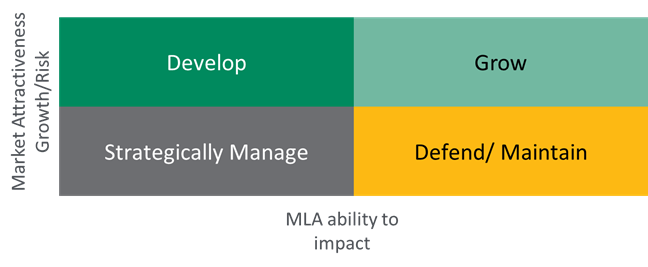Segmenting market opportunities
Australia exports red meat to more than 100 markets around the world and MLA invests approximately $44 million in global marketing programs to ensure Australia is capitalising on global opportunities.
With such a significant investment and a diverse range of markets to cover, it is critical that MLA uses a targeted strategy to determine how best to invest industry funds.
MLA’s Global Markets Strategy uses a portfolio matrix approach to segment these global market opportunities. The strategy is based on a wide range of variables that together provide an indication of future demand, highlighting opportunities and challenges. These variables are data driven and indicate market growth and risk (market attractiveness) and the ability to have an impact (MLA ability to impact).
The matrix consists of 21 market factors or forces that are used to determine how markets are classified. ‘Market attractiveness’ includes variables like household income, historical exports, forecast red meat consumption, price sensitivity and competition. ‘MLA’s ability to impact’ includes variables like economic access, technical access, trade organisation and retail presence.
The portfolio matrix consists of four strategic market classifications that we use to determine the investment in each market:

These classifications are described in the below table:
| Portfolio classification | Description | Objective | Strategy |
| Develop | Markets that show potential income growth and have a longer term horizon potential | Position Australia favourably to capture growth opportunities | Monitor market opportunities and develop targeted growth strategies |
| Grow | Markets with higher population growth, positive economic positioning and increasing household incomes | Maximise current growth opportunities | Drive trial and usage through demonstration and education about the benefits of Australian red meat |
| Defend/maintain | Existing markets that have limited growth opportunities but represent significant importance to the Australian red meat industry | Protect position in the market/ strengthen current position and maximise return | Reinforce and remind the market about the benefits of Australian red meat. Also drive brand value and demonstrate higher value benefits |
| Manage strategically | Markets that have restrictive access barriers or represent limited opportunities | Minimise risk and identify future opportunities | Develop strategies to minimise access barriers and maintain a watching brief |
These classifications are reviewed annually as part of MLA’s industry consultation process, with market developments and industry feedback being built into annual implementation plans.
More information
Michael Finucan
MLA General Manager, International Markets
mfinucan@mla.com.au



